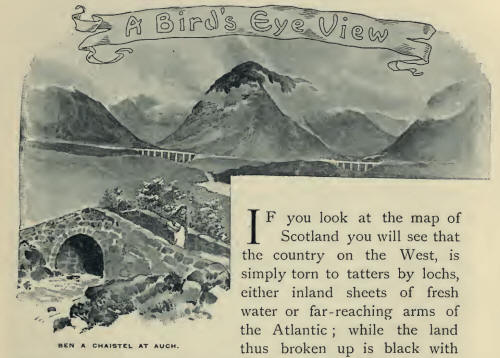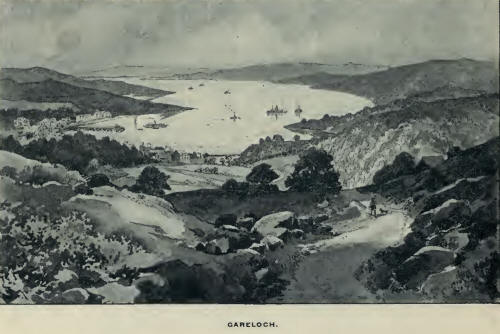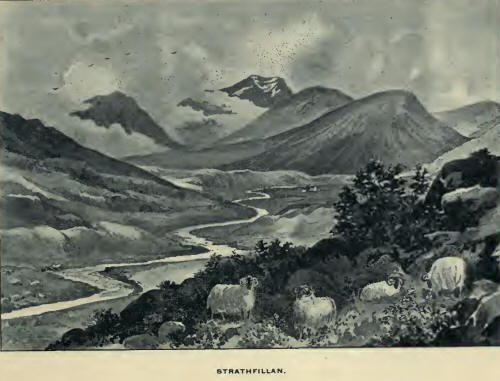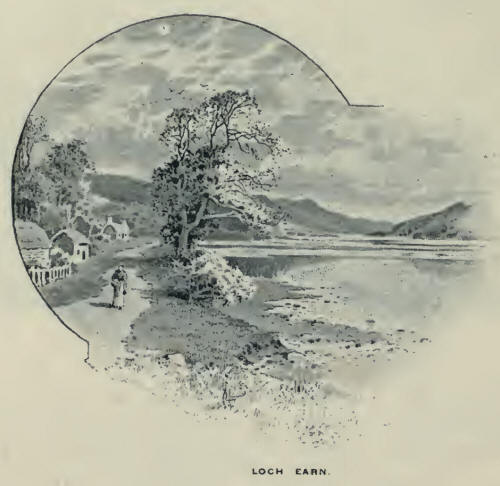
hill-shading wherever the streaks and patches of blue
leave a tract of dry land big enough to build a mountain upon. Argyllshire,
Inverness-shire, Perthshire and Dumbartonshire, as presented by the maker of
maps, may be compared to the colours of some fighting regiment, after half a
century of arduous campaigning, blackened by powder and rent by bullet. This
is putting it poetically, but a more prosaic comparison would be to say that
these West Highlands on the map are like a cabbage-leaf devoured by
caterpillars.

Such a wild and picturesque district is a very
Paradise for the tourist, but hitherto this "Land of Mountain, Moor and
Loch" has been remarkably difficult of access. It is traversed diagonally by
the chain of lochs that form the. Caledonian Canal, cutting through
Argyllshire and Inverness- shire from the Island of Mull to the Moray Firth,
like the straight slash of a knife, and the traveller has been enabled to
skirt these rugged shires by steamer, while he has also been able to
penetrate tar into Argyll and Dumbarton by the great southern lochs; but
where the paddle-wheel ceased to revolve there has been no locomotive to
take up the running. From the stopping-points of the steamers, there have
been a few coach routes, but these have covered only an infinitesimal part
of this marvellously beautiful country, and hitherto the land west of the
Grampians, from Lochaber, south to the sea, has been left almost alone to
the pedestrian or cyclist of untiring muscle. Hitherto one railway alone has
intruded amongst these glorious glens, these frowning peaks and gleaming
lochs—the line that runs from Kuhn in Perthshire, almost due west, bisecting
the Argyllshire Highlands. But nearly all the passengers by this route have
been making straight for the terminus at Oban, and in the short run after
the Grampians are crossed, have had nothing more than a glimpse of the
scenery now completely opened up from South to North.

The West Highland Railway, now completed, breaks fresh
ground from start to finish of its hundred-mile run; carrying the traveller
through what is, perhaps, the most sublime and characteristic portion of
Scotland. Taking up at Helensburgh, which lies at the mouth of the Gareloch,
an uncompleted end of the North British Railway, it winds northwards along
the base of the Grampians to Inverlair, whence it strikes westwards through
Lochaber to Fort William on Loch Linnhe, which with a branch to Banavie,
makes connection with the Caledonian Canal, and brings within the reach of
the traveller the most tempting possibilities in the way of circular tours.
Now in Dumbartonshire, now in Perthshire, now in Argyllshire, now in
Perthshire again, now in Inverness-shire, it never for one moment meets the
prosaic: the panorama of landscape that passes before the carriage windows
changing almost every minute, into more and more bewitching visions of
infinite variety. As the Irish navy engaged on the construction of the line
observed, "Sure, it's the most amphibious country ever seen by the naked
eye"—so many sheets of deep blue water break upon the sight as the train
sweeps round each curve, that to the non-engineering traveller, it seems as
if a new Caledonian Canal might have been constructed almost as easily as a
railway; while the hills are piled on each other in such multitudinous
profusion that the opening out of each new vista of towering peaks fairly
intoxicates an artist with delight.
The scenery may be divided roughly into four sections.
From Helensburgh to Ardlui the line hugs in succession the shores of three
great lochs—Gareloch, Loch Long, and Loch Lomond—which cleave their way
through grand mountain barriers ; from Ardlui to Gortan, it threads its
course along a bewildering maze of stupendous crags from Gortan to Rannoch,
it traverses the great Moor of Rannoch, which has no parallel in Britain ;
and from Rannoch to Fort William it passes through a country that combines
all the features of the previous stretches, loch, moor and glen, overhung-
by vast eminences scattered over the land with lavish prodigality— Ben
Lomond, Ben Irne, Ben Vane, Ben Voirlich, Ben More, Ben Doran, and a phalanx
of other mountains, culminating in mighty Ben Nevis. Never was there a
railway that less disfigured the country through which it passed. Like a
mere scratch on the mountain slopes, it glides from valley to valley,
unobtrusive as a sheep path, and not even John Ruskin would regard it as a
desecration of the Highland solitudes. Along the course of this West
Highland Railway little evidence of cultivation meets the eye of the
superficial observer; and yet many of the best sheep farms of Scotland—in
some instances feeding not less than 20,000 head of the finest black-faced
sheep of the country—are found on the lands traversed by it. It is a land of
sport, the home of the deer, the grouse and the white hare, while the
streams abound with trout, and those who know it will cease to wonder why
the old clansmen who inhabited those bare yet beautiful glens sought so
often and so successfully to make the cattle of the Lowlands their own. Up
to Ardlui, houses are far apart, but still one feels that the country is
inhabited; north of that place houses are few, and when a dwelling-place
appears it is generally a low thatched hut, and you have to look twice
before asserting dogmatically which is the house and which is the haystack.
If ever there was a railway which was so evidently a
railway for the tourist and holiday-seeker, it is the West Highland.
Manufactures there are none, but the railway will give to agriculture and
farming, facilities hitherto unknown, and there will, without doubt, be an
increased traffic in sheep and cattle, which will find a new outlet to the
South from the districts converging on Spean Bridge and at other points of
the line. Industries will doubtless grow, now that the railway is opened,
but goods traffic will require some years to develop, although the
well-known "Long John" whiskies of Fort William will contribute something.
It opens up a world hitherto known only to the sportsman and to the
comparative few who, with abundant leisure and means, could penetrate the
magnificent country through which it passes. Beyond this, the extensive
country which is brought within

easy access of the commercial metropolis of Scotland
will be developed by the industry and enterprise, characteristic of the
industrious and intelligent community which has given Glasgow so prominent a
place among the cities of the Empire. Not only does it throw open a new land
of promise, as we have shown, but it will shorten by upwards of an hour the
journey between Edinburgh or Glasgow and Oban —a watering-place that
requires no introduction to popular favour. Along the line, coach roads
strike off to right and left, taking the traveller through the many
interesting districts into which the railway runs—the "Rob Roy" country, the
"Lady of the Lake" country, and the ever famous Glencoe—making connection
with steamboat services on the lochs, and transporting him whither he will,
by land or by water, over this happy hunting ground of the tourist. Now that
the bridle track and sheep path have been supplemented by the iron-way, in
such an embarrassment of alluring alternatives, the difficulty is not to
find a route, but to select one, for the West Highland Railway emphatically
forms perhaps the greatest of the great "show-routes" of Britain.

|

